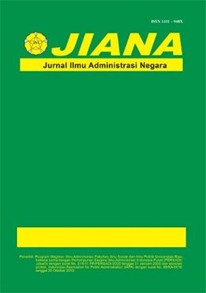FAKTOR YANG MEMPENGARUHI TURNOVER KARYAWAN DAN STRATEGI RETENSI SEBAGAI PENCEGAHAN TURNOVER KARYAWAN : SEBUAH TINJAUAN LITERATUR
DOI:
https://doi.org/10.46730/jiana.v18i2.7926Keywords:
turnover, retention, human resources.Abstract
Factors Affecting Employee Turnover and Retention Strategies as Prevention of Employee Turnover: A Literature Review. Turnover can be interpreted as the discharge of an employee from the company where he works. Turnover in organizations can lead to instability and uncertainty about labor conditions and will increase costs that must be incurred by the organization. Turnover can be experienced by organizations in the private and public sectors. The writing of this article uses the literature review data collection method for various reports, publications or news about employee turnover. There are several factors that influence employees in making decisions to stay or leave the organization, among others: employee factors, organizational factors and environmental factors. The organization needs to find out the factors that cause turnover in its organization, so that the organization can prevent turnover. Employee retention is the organization's strategy to maintain the potential employees of the organization to remain loyal to the organization. If the employee retention strategy is implemented well, employee turnover will be reduced.References
Buku
Byars, L. L. dan Rue, L. W. (1997). Human Resources Management (Fifth edition). Chicago : The McGraw-Hill Companies, Inc.
Creswell, J. W. (2009). Research Design : Pendekatan Kualitatif, Kuantitatif, dan Mixed. Yogyakarta : Pustaka Pelajar.
Dessler, G. (2013). Human Resource Management (Thirteenth Edition). London: Pearson Education.
Gibson, J. L., Ivancevich, dan James H. Donnelly. (2003). Organizations Behaviour, Structure and Process. (8th ed). Boston: Richard D. Irwin Inc.
Handoko, T. H. (2000). Manajemen Personalia dan Sumberdaya Manusia Edisi II (Cetakan Keempat Belas). Yogyakarta : BPFE.
Lussier, N. R. (2005). Human Relations in Organization Applications and Skill Building. New York : Mc Graw Hill.
Mathis, R. L dan Jackson, J. H. (2006). Manajemen Sumber Daya Manusia. Jakarta : Salemba Empat.
Mobley, W. H. (1986). Pergantian Karyawan : Sebab, Akibat dan Pengendaliannya. (Aliha Bahasa : Nurul Imam). Jakarta : PT. Pustaka Binaman Pressindo.
Mondy, R. W. (2008). Manajemen Sumber Daya Manusia. Jakarta : Erlangga.
Robbins, S. P. (2006). Perilaku Organisasi (Edisi Sepuluh). Jakarta : Erlangga.
Siagian, S. P. (1995). Teori Motivasi dan Aplikasinya. Jakarta : PT Rineka Cipta.
Simamora, H. (2004). Manajemen Sumber Daya Manusia. Yogyakarta : STIE YKPN.
Torrington, D., Hall, L., Taylor, S. (2008), Human Resource Management. England : Prentice Hall, Pearson Education Limited.
Zeffane. (2003). Organizational Behavior A Global Perspective. Australia : John Wiley and Sons Australia Ltd.
Jurnal
Abelson, M. A. (1987). Examination of Avoidable and Unavoidable Turnover. Journal of Applied Phsychology, 72 : 382-386.
Abelson, M. A. (1986). Strategic Management of Turnover : A Model For The Health Service Administrator. Journal HCMR, 11(2), 61-71.
Lockwood, N. R. (2007). Leveraging Employee Engagements for Competitive Advantage: HRs Strategic Role. HR Magazine, 52(3), pp. 1-11.
McBey, Kenneth and Karakowsky, L. (2000). Examining Sources of Influence on Employee Turnover in The Part-Time Work Context, Leadership and Organization Journal, Vol. 21 No. 3.
McKenna, T. (2006). The Loyalty Quotient. Journal National Petroleum News Vol 4.
Muchinsky, P. dan Morrow, P. (1980). A Multidisciplinary Model of Voluntary Employee Turnover. Journal of Vocational Behavior, 17, 263-290.
Nasution, W. A. (2009). Pengaruh Kepuasan Kerja Karyawan Terhadap Intensi Turnover Pada Call Center Telkomsel di Medan. Jurnal Mandiri Vol 4, No 1. ISSN 1907-4158.
Rousseau, D. M. (1989). Psychological And Implied Contract In Organization. Employee Right and Responsibilities Journal, Vol. 2, 121-139.
Sheridan, J. E. dan Abelson, M. A. (1983). Cusp Catastrophe Model of Employee Turnover. Academy of Management Journal, 26(3), 418-436.
Shaw, J. D. (2011). Turnover Rates and Organizational Performance : Review, Critique and Research Agenda. Organizational Psychology Review, 1 : 187.
Shaw, J. D., Delery, J. E., Jenkins, G. D., dan Gupta, N. (1998). An Organization-level Analysis of Voluntary and Involuntary Turnover. Academy of Management Journal 41.
Susilo, A. (2013). Pengaruh Retensi Karyawan dan Kepuasan Pelanggan Terhadap Kinerja. Jurnal Studi Akuntansi dan Bisnis, 251, Vol 1, No 3.
Syahril, R. R. dan Nurbiyati, T. (1998). Pengaruh Reward Ektrinsik dan Intrinsik Terhadap Kinerja Dengan Kepuasan Kerja Sebagai Variable Intervening. Jurnal RIset Manajemen, Vol 3 No 1, 23-37.
Zeffane, R. M. (1994). Understanding Employee Turnover : The Need for a Contingency Approach. International Journal of Manpower, 15, 22-38.
Tesis
Ikhwanto, J. (2015). Hubungan Antara Kepuasan Kerja Dengan Intensi Turnover Pada Karyawan. FPSI Universitas Muhammadiyah Surakarta, Surakarta.
Subali. (2017). Kajian Terhadap Penerapan Employee Retention Sebagai Upaya Pencegahan Turnover Pegawai (Kasus Pada Badan Kepegawaian Negara). FIA Universitas Indonesia, Depok.
Utami, P. (2015). Gambaran Turnover Perawat Rawat Inap Anak Rumah Sakit Umum X Tahun 2014. FKM Universitas Indonesia, Depok.
Downloads
Published
How to Cite
Issue
Section
License
The copyright of the received article shall be assigned to the journal as the publisher of the journal. The intended copyright includes the right to publish the article in various forms (including reprints). The journal maintains the publishing rights to the published articles.
Authors are permitted to disseminate published articles by sharing the link/DOI of the article at the journal. Authors are allowed to use their articles for any legal purposes deemed necessary without written permission from the journal with an acknowledgment of initial publication to this journal.

Jurnal Ilmu Administrasi Publik is licensed under a Creative Commons Attribution-NonCommercial-ShareAlike 4.0 International License.




